Financial Management Report: Budgeting and Decisions
VerifiedAdded on 2023/01/11
|9
|2200
|93
Report
AI Summary
This report delves into key aspects of financial management, encompassing budgeting, decision-making, and capital investment strategies. It begins with an exploration of budgeting, emphasizing its significance in planning future income and expenditures and the external influences that shape budget preparation. The report then transitions to decision-making processes, highlighting the importance of analyzing costs, benefits, and contribution margins. It examines capital budgeting techniques, such as net present value (NPV) and payback period, to assess investment viability. Furthermore, the report provides a financial analysis of product profitability, including the calculation of contribution margins and the identification of areas for improvement. Finally, it analyzes capital investment decisions, comparing two project options using NPV and payback period to determine the most beneficial investment for the company.
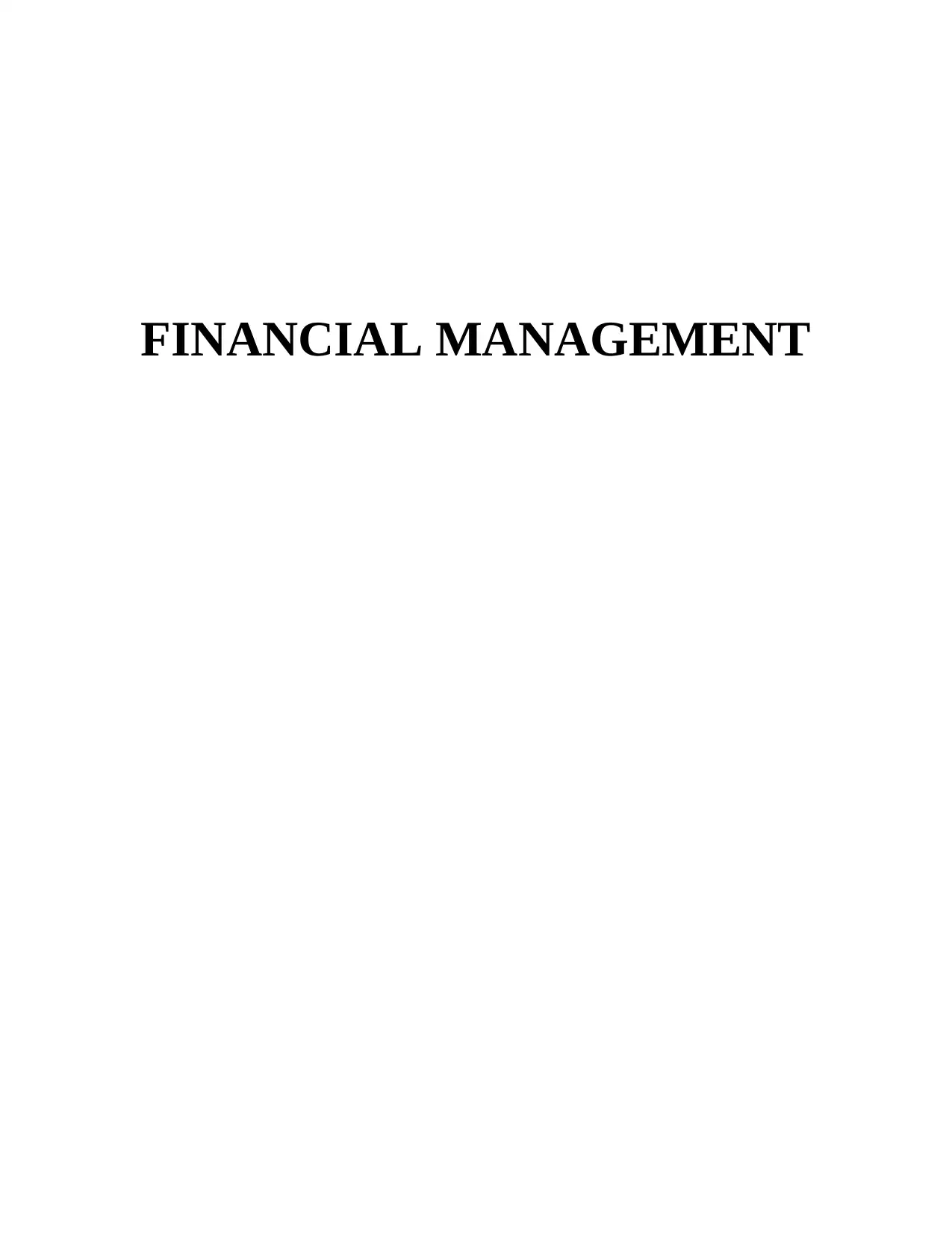
FINANCIAL MANAGEMENT
Paraphrase This Document
Need a fresh take? Get an instant paraphrase of this document with our AI Paraphraser

TABLE OF CONTENTS
TABLE OF CONTENTS................................................................................................................2
Step 5...........................................................................................................................................1
Step 6...........................................................................................................................................2
Step 7...........................................................................................................................................4
Step 9...........................................................................................................................................6
TABLE OF CONTENTS................................................................................................................2
Step 5...........................................................................................................................................1
Step 6...........................................................................................................................................2
Step 7...........................................................................................................................................4
Step 9...........................................................................................................................................6
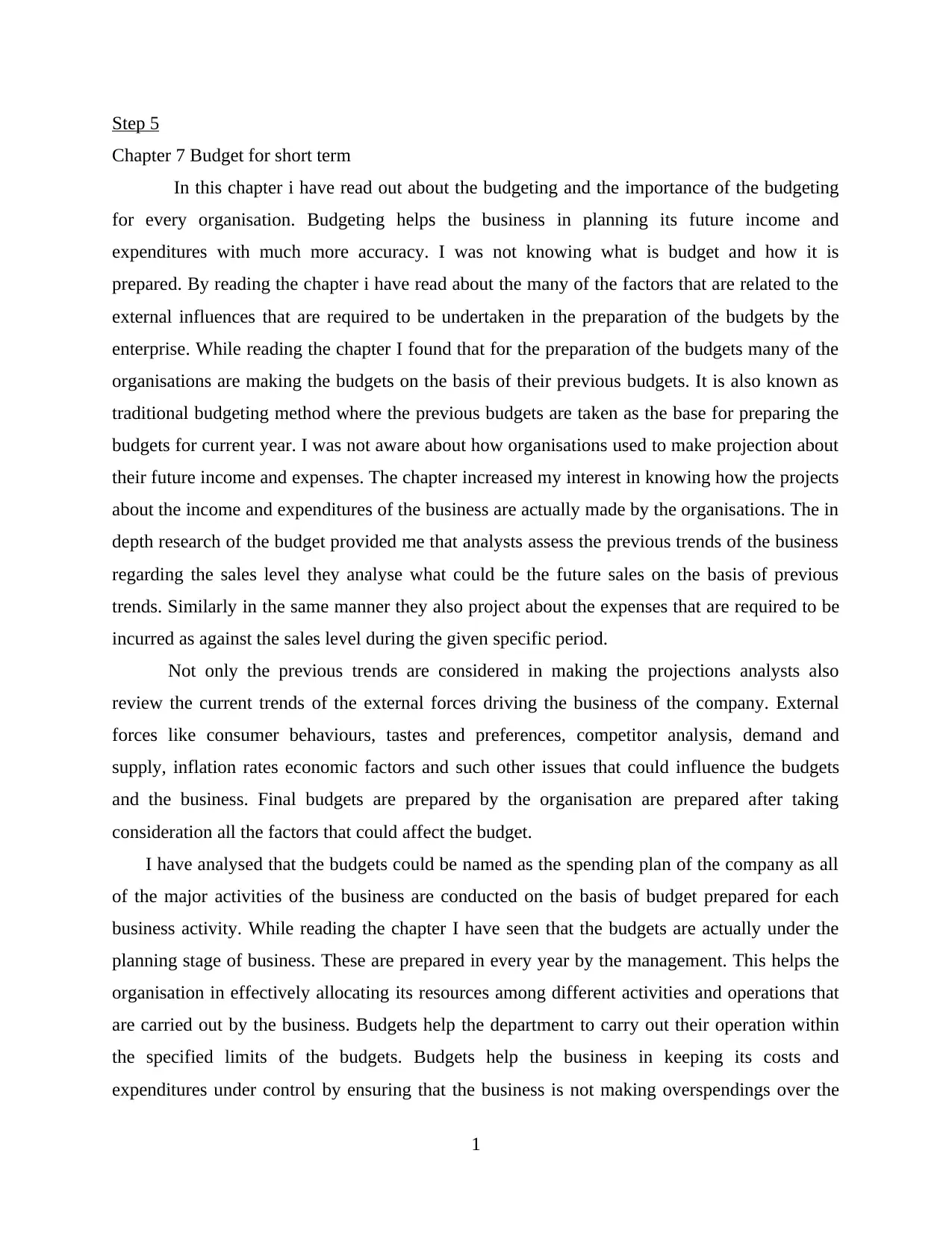
Step 5
Chapter 7 Budget for short term
In this chapter i have read out about the budgeting and the importance of the budgeting
for every organisation. Budgeting helps the business in planning its future income and
expenditures with much more accuracy. I was not knowing what is budget and how it is
prepared. By reading the chapter i have read about the many of the factors that are related to the
external influences that are required to be undertaken in the preparation of the budgets by the
enterprise. While reading the chapter I found that for the preparation of the budgets many of the
organisations are making the budgets on the basis of their previous budgets. It is also known as
traditional budgeting method where the previous budgets are taken as the base for preparing the
budgets for current year. I was not aware about how organisations used to make projection about
their future income and expenses. The chapter increased my interest in knowing how the projects
about the income and expenditures of the business are actually made by the organisations. The in
depth research of the budget provided me that analysts assess the previous trends of the business
regarding the sales level they analyse what could be the future sales on the basis of previous
trends. Similarly in the same manner they also project about the expenses that are required to be
incurred as against the sales level during the given specific period.
Not only the previous trends are considered in making the projections analysts also
review the current trends of the external forces driving the business of the company. External
forces like consumer behaviours, tastes and preferences, competitor analysis, demand and
supply, inflation rates economic factors and such other issues that could influence the budgets
and the business. Final budgets are prepared by the organisation are prepared after taking
consideration all the factors that could affect the budget.
I have analysed that the budgets could be named as the spending plan of the company as all
of the major activities of the business are conducted on the basis of budget prepared for each
business activity. While reading the chapter I have seen that the budgets are actually under the
planning stage of business. These are prepared in every year by the management. This helps the
organisation in effectively allocating its resources among different activities and operations that
are carried out by the business. Budgets help the department to carry out their operation within
the specified limits of the budgets. Budgets help the business in keeping its costs and
expenditures under control by ensuring that the business is not making overspendings over the
1
Chapter 7 Budget for short term
In this chapter i have read out about the budgeting and the importance of the budgeting
for every organisation. Budgeting helps the business in planning its future income and
expenditures with much more accuracy. I was not knowing what is budget and how it is
prepared. By reading the chapter i have read about the many of the factors that are related to the
external influences that are required to be undertaken in the preparation of the budgets by the
enterprise. While reading the chapter I found that for the preparation of the budgets many of the
organisations are making the budgets on the basis of their previous budgets. It is also known as
traditional budgeting method where the previous budgets are taken as the base for preparing the
budgets for current year. I was not aware about how organisations used to make projection about
their future income and expenses. The chapter increased my interest in knowing how the projects
about the income and expenditures of the business are actually made by the organisations. The in
depth research of the budget provided me that analysts assess the previous trends of the business
regarding the sales level they analyse what could be the future sales on the basis of previous
trends. Similarly in the same manner they also project about the expenses that are required to be
incurred as against the sales level during the given specific period.
Not only the previous trends are considered in making the projections analysts also
review the current trends of the external forces driving the business of the company. External
forces like consumer behaviours, tastes and preferences, competitor analysis, demand and
supply, inflation rates economic factors and such other issues that could influence the budgets
and the business. Final budgets are prepared by the organisation are prepared after taking
consideration all the factors that could affect the budget.
I have analysed that the budgets could be named as the spending plan of the company as all
of the major activities of the business are conducted on the basis of budget prepared for each
business activity. While reading the chapter I have seen that the budgets are actually under the
planning stage of business. These are prepared in every year by the management. This helps the
organisation in effectively allocating its resources among different activities and operations that
are carried out by the business. Budgets help the department to carry out their operation within
the specified limits of the budgets. Budgets help the business in keeping its costs and
expenditures under control by ensuring that the business is not making overspendings over the
1
You're viewing a preview
Unlock full access by subscribing today!
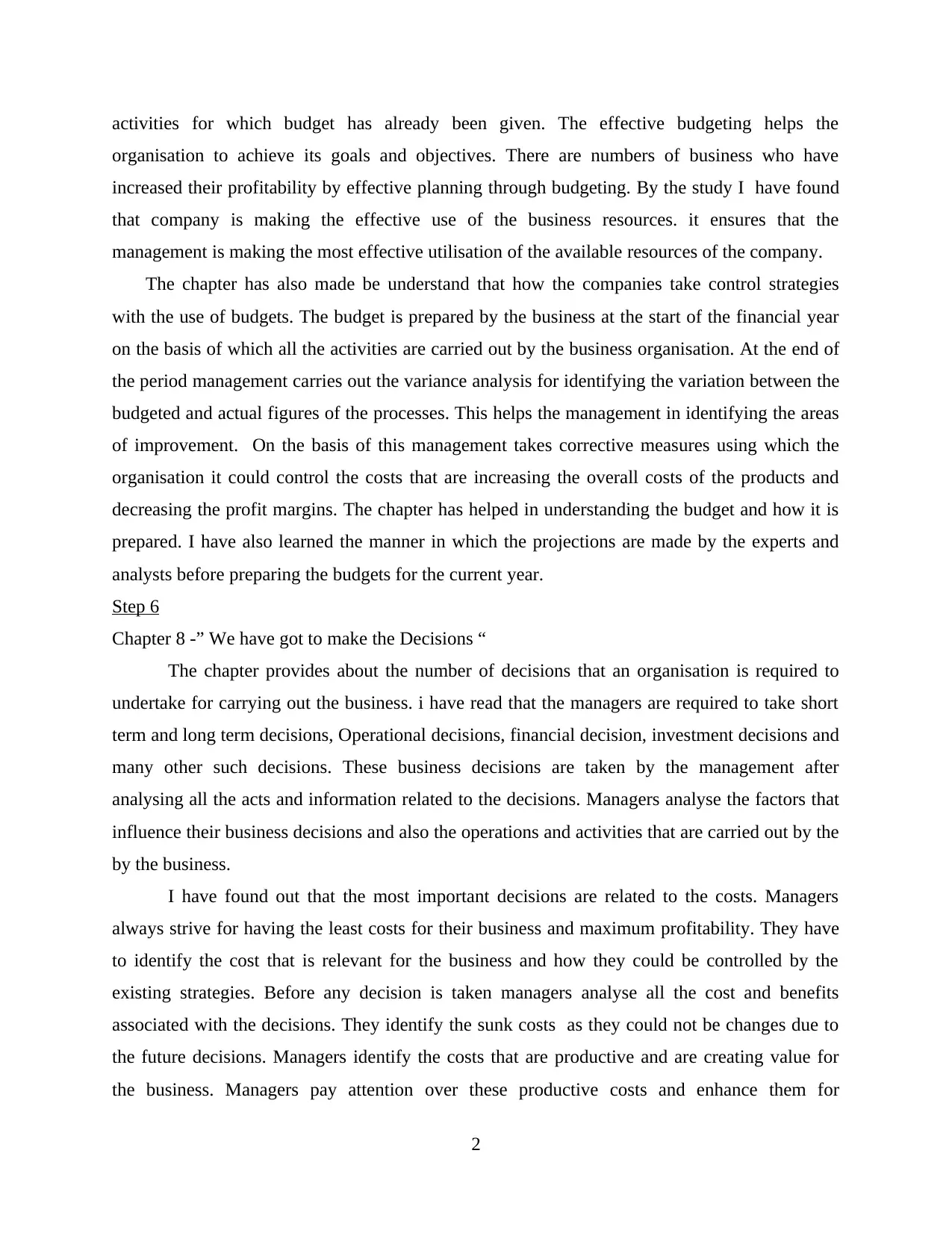
activities for which budget has already been given. The effective budgeting helps the
organisation to achieve its goals and objectives. There are numbers of business who have
increased their profitability by effective planning through budgeting. By the study I have found
that company is making the effective use of the business resources. it ensures that the
management is making the most effective utilisation of the available resources of the company.
The chapter has also made be understand that how the companies take control strategies
with the use of budgets. The budget is prepared by the business at the start of the financial year
on the basis of which all the activities are carried out by the business organisation. At the end of
the period management carries out the variance analysis for identifying the variation between the
budgeted and actual figures of the processes. This helps the management in identifying the areas
of improvement. On the basis of this management takes corrective measures using which the
organisation it could control the costs that are increasing the overall costs of the products and
decreasing the profit margins. The chapter has helped in understanding the budget and how it is
prepared. I have also learned the manner in which the projections are made by the experts and
analysts before preparing the budgets for the current year.
Step 6
Chapter 8 -” We have got to make the Decisions “
The chapter provides about the number of decisions that an organisation is required to
undertake for carrying out the business. i have read that the managers are required to take short
term and long term decisions, Operational decisions, financial decision, investment decisions and
many other such decisions. These business decisions are taken by the management after
analysing all the acts and information related to the decisions. Managers analyse the factors that
influence their business decisions and also the operations and activities that are carried out by the
by the business.
I have found out that the most important decisions are related to the costs. Managers
always strive for having the least costs for their business and maximum profitability. They have
to identify the cost that is relevant for the business and how they could be controlled by the
existing strategies. Before any decision is taken managers analyse all the cost and benefits
associated with the decisions. They identify the sunk costs as they could not be changes due to
the future decisions. Managers identify the costs that are productive and are creating value for
the business. Managers pay attention over these productive costs and enhance them for
2
organisation to achieve its goals and objectives. There are numbers of business who have
increased their profitability by effective planning through budgeting. By the study I have found
that company is making the effective use of the business resources. it ensures that the
management is making the most effective utilisation of the available resources of the company.
The chapter has also made be understand that how the companies take control strategies
with the use of budgets. The budget is prepared by the business at the start of the financial year
on the basis of which all the activities are carried out by the business organisation. At the end of
the period management carries out the variance analysis for identifying the variation between the
budgeted and actual figures of the processes. This helps the management in identifying the areas
of improvement. On the basis of this management takes corrective measures using which the
organisation it could control the costs that are increasing the overall costs of the products and
decreasing the profit margins. The chapter has helped in understanding the budget and how it is
prepared. I have also learned the manner in which the projections are made by the experts and
analysts before preparing the budgets for the current year.
Step 6
Chapter 8 -” We have got to make the Decisions “
The chapter provides about the number of decisions that an organisation is required to
undertake for carrying out the business. i have read that the managers are required to take short
term and long term decisions, Operational decisions, financial decision, investment decisions and
many other such decisions. These business decisions are taken by the management after
analysing all the acts and information related to the decisions. Managers analyse the factors that
influence their business decisions and also the operations and activities that are carried out by the
by the business.
I have found out that the most important decisions are related to the costs. Managers
always strive for having the least costs for their business and maximum profitability. They have
to identify the cost that is relevant for the business and how they could be controlled by the
existing strategies. Before any decision is taken managers analyse all the cost and benefits
associated with the decisions. They identify the sunk costs as they could not be changes due to
the future decisions. Managers identify the costs that are productive and are creating value for
the business. Managers pay attention over these productive costs and enhance them for
2
Paraphrase This Document
Need a fresh take? Get an instant paraphrase of this document with our AI Paraphraser
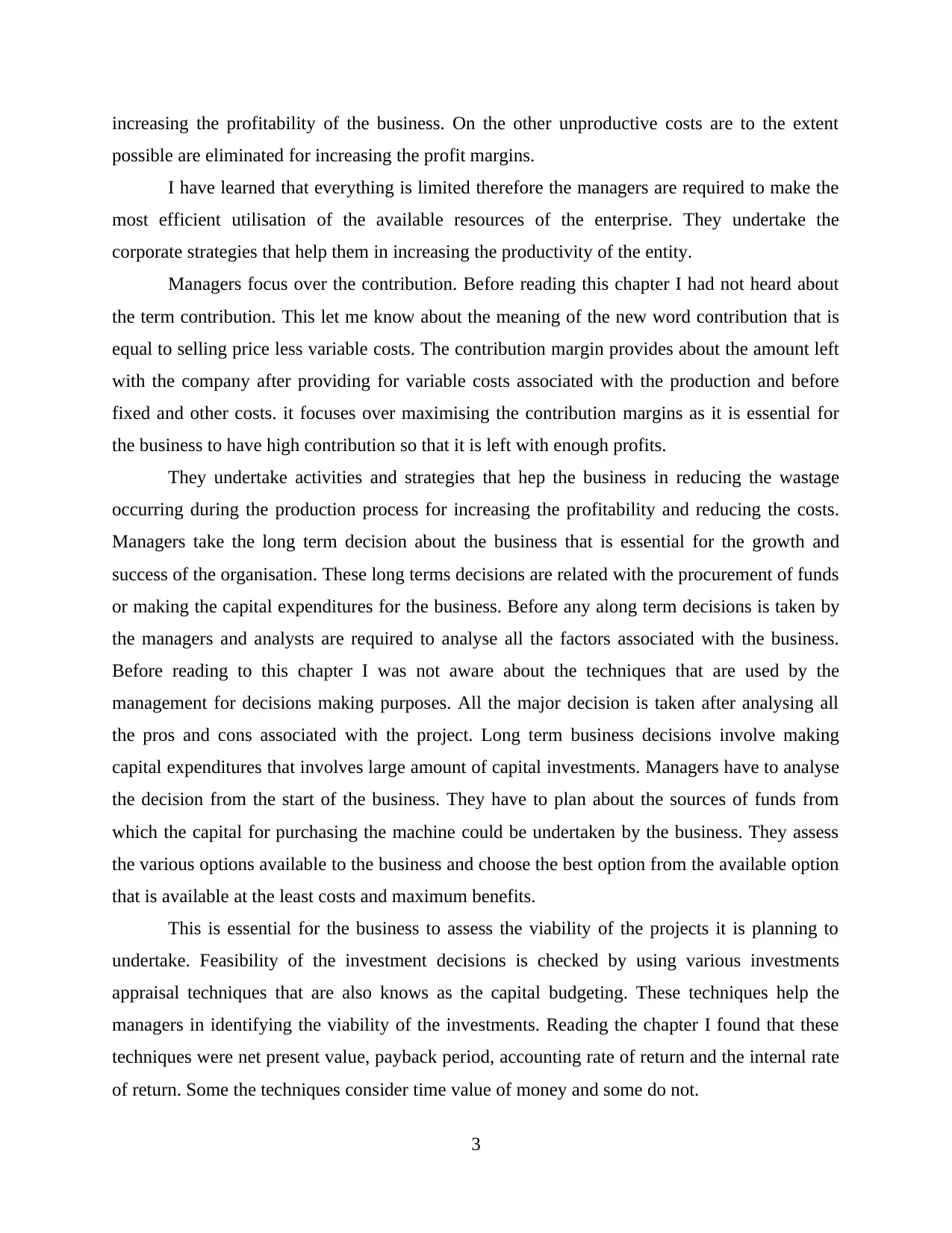
increasing the profitability of the business. On the other unproductive costs are to the extent
possible are eliminated for increasing the profit margins.
I have learned that everything is limited therefore the managers are required to make the
most efficient utilisation of the available resources of the enterprise. They undertake the
corporate strategies that help them in increasing the productivity of the entity.
Managers focus over the contribution. Before reading this chapter I had not heard about
the term contribution. This let me know about the meaning of the new word contribution that is
equal to selling price less variable costs. The contribution margin provides about the amount left
with the company after providing for variable costs associated with the production and before
fixed and other costs. it focuses over maximising the contribution margins as it is essential for
the business to have high contribution so that it is left with enough profits.
They undertake activities and strategies that hep the business in reducing the wastage
occurring during the production process for increasing the profitability and reducing the costs.
Managers take the long term decision about the business that is essential for the growth and
success of the organisation. These long terms decisions are related with the procurement of funds
or making the capital expenditures for the business. Before any along term decisions is taken by
the managers and analysts are required to analyse all the factors associated with the business.
Before reading to this chapter I was not aware about the techniques that are used by the
management for decisions making purposes. All the major decision is taken after analysing all
the pros and cons associated with the project. Long term business decisions involve making
capital expenditures that involves large amount of capital investments. Managers have to analyse
the decision from the start of the business. They have to plan about the sources of funds from
which the capital for purchasing the machine could be undertaken by the business. They assess
the various options available to the business and choose the best option from the available option
that is available at the least costs and maximum benefits.
This is essential for the business to assess the viability of the projects it is planning to
undertake. Feasibility of the investment decisions is checked by using various investments
appraisal techniques that are also knows as the capital budgeting. These techniques help the
managers in identifying the viability of the investments. Reading the chapter I found that these
techniques were net present value, payback period, accounting rate of return and the internal rate
of return. Some the techniques consider time value of money and some do not.
3
possible are eliminated for increasing the profit margins.
I have learned that everything is limited therefore the managers are required to make the
most efficient utilisation of the available resources of the enterprise. They undertake the
corporate strategies that help them in increasing the productivity of the entity.
Managers focus over the contribution. Before reading this chapter I had not heard about
the term contribution. This let me know about the meaning of the new word contribution that is
equal to selling price less variable costs. The contribution margin provides about the amount left
with the company after providing for variable costs associated with the production and before
fixed and other costs. it focuses over maximising the contribution margins as it is essential for
the business to have high contribution so that it is left with enough profits.
They undertake activities and strategies that hep the business in reducing the wastage
occurring during the production process for increasing the profitability and reducing the costs.
Managers take the long term decision about the business that is essential for the growth and
success of the organisation. These long terms decisions are related with the procurement of funds
or making the capital expenditures for the business. Before any along term decisions is taken by
the managers and analysts are required to analyse all the factors associated with the business.
Before reading to this chapter I was not aware about the techniques that are used by the
management for decisions making purposes. All the major decision is taken after analysing all
the pros and cons associated with the project. Long term business decisions involve making
capital expenditures that involves large amount of capital investments. Managers have to analyse
the decision from the start of the business. They have to plan about the sources of funds from
which the capital for purchasing the machine could be undertaken by the business. They assess
the various options available to the business and choose the best option from the available option
that is available at the least costs and maximum benefits.
This is essential for the business to assess the viability of the projects it is planning to
undertake. Feasibility of the investment decisions is checked by using various investments
appraisal techniques that are also knows as the capital budgeting. These techniques help the
managers in identifying the viability of the investments. Reading the chapter I found that these
techniques were net present value, payback period, accounting rate of return and the internal rate
of return. Some the techniques consider time value of money and some do not.
3
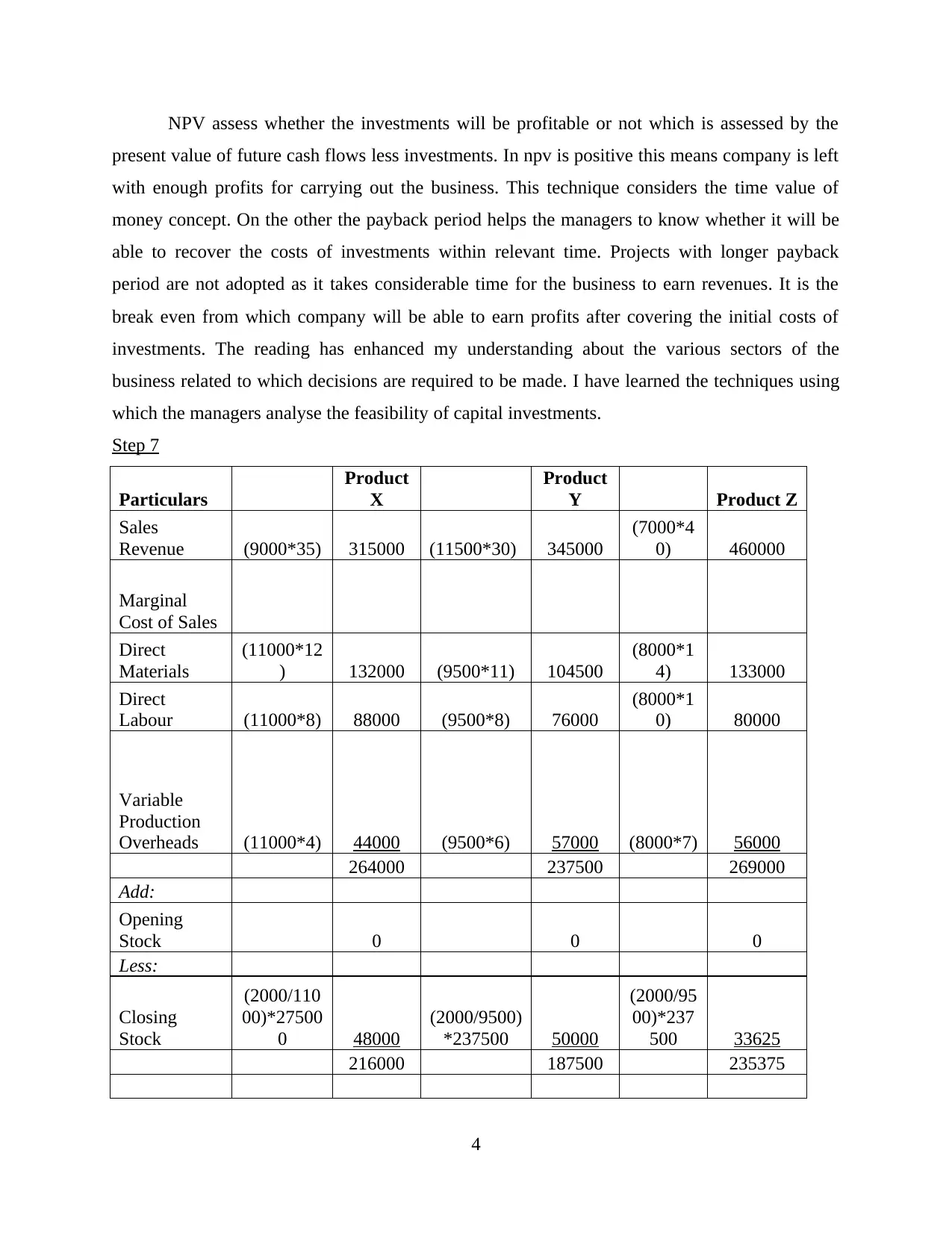
NPV assess whether the investments will be profitable or not which is assessed by the
present value of future cash flows less investments. In npv is positive this means company is left
with enough profits for carrying out the business. This technique considers the time value of
money concept. On the other the payback period helps the managers to know whether it will be
able to recover the costs of investments within relevant time. Projects with longer payback
period are not adopted as it takes considerable time for the business to earn revenues. It is the
break even from which company will be able to earn profits after covering the initial costs of
investments. The reading has enhanced my understanding about the various sectors of the
business related to which decisions are required to be made. I have learned the techniques using
which the managers analyse the feasibility of capital investments.
Step 7
Particulars
Product
X
Product
Y Product Z
Sales
Revenue (9000*35) 315000 (11500*30) 345000
(7000*4
0) 460000
Marginal
Cost of Sales
Direct
Materials
(11000*12
) 132000 (9500*11) 104500
(8000*1
4) 133000
Direct
Labour (11000*8) 88000 (9500*8) 76000
(8000*1
0) 80000
Variable
Production
Overheads (11000*4) 44000 (9500*6) 57000 (8000*7) 56000
264000 237500 269000
Add:
Opening
Stock 0 0 0
Less:
Closing
Stock
(2000/110
00)*27500
0 48000
(2000/9500)
*237500 50000
(2000/95
00)*237
500 33625
216000 187500 235375
4
present value of future cash flows less investments. In npv is positive this means company is left
with enough profits for carrying out the business. This technique considers the time value of
money concept. On the other the payback period helps the managers to know whether it will be
able to recover the costs of investments within relevant time. Projects with longer payback
period are not adopted as it takes considerable time for the business to earn revenues. It is the
break even from which company will be able to earn profits after covering the initial costs of
investments. The reading has enhanced my understanding about the various sectors of the
business related to which decisions are required to be made. I have learned the techniques using
which the managers analyse the feasibility of capital investments.
Step 7
Particulars
Product
X
Product
Y Product Z
Sales
Revenue (9000*35) 315000 (11500*30) 345000
(7000*4
0) 460000
Marginal
Cost of Sales
Direct
Materials
(11000*12
) 132000 (9500*11) 104500
(8000*1
4) 133000
Direct
Labour (11000*8) 88000 (9500*8) 76000
(8000*1
0) 80000
Variable
Production
Overheads (11000*4) 44000 (9500*6) 57000 (8000*7) 56000
264000 237500 269000
Add:
Opening
Stock 0 0 0
Less:
Closing
Stock
(2000/110
00)*27500
0 48000
(2000/9500)
*237500 50000
(2000/95
00)*237
500 33625
216000 187500 235375
4
You're viewing a preview
Unlock full access by subscribing today!
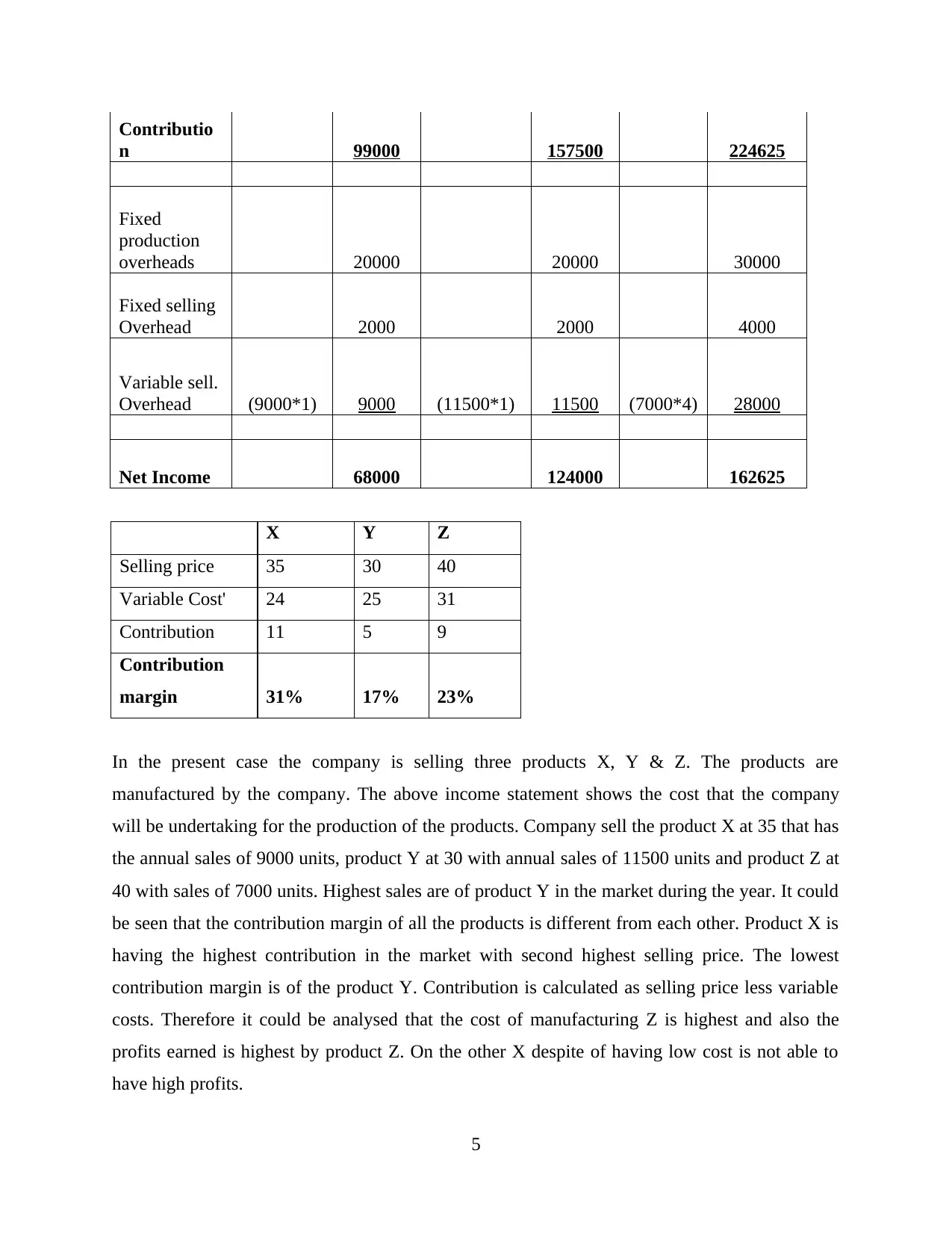
Contributio
n 99000 157500 224625
Fixed
production
overheads 20000 20000 30000
Fixed selling
Overhead 2000 2000 4000
Variable sell.
Overhead (9000*1) 9000 (11500*1) 11500 (7000*4) 28000
Net Income 68000 124000 162625
X Y Z
Selling price 35 30 40
Variable Cost' 24 25 31
Contribution 11 5 9
Contribution
margin 31% 17% 23%
In the present case the company is selling three products X, Y & Z. The products are
manufactured by the company. The above income statement shows the cost that the company
will be undertaking for the production of the products. Company sell the product X at 35 that has
the annual sales of 9000 units, product Y at 30 with annual sales of 11500 units and product Z at
40 with sales of 7000 units. Highest sales are of product Y in the market during the year. It could
be seen that the contribution margin of all the products is different from each other. Product X is
having the highest contribution in the market with second highest selling price. The lowest
contribution margin is of the product Y. Contribution is calculated as selling price less variable
costs. Therefore it could be analysed that the cost of manufacturing Z is highest and also the
profits earned is highest by product Z. On the other X despite of having low cost is not able to
have high profits.
5
n 99000 157500 224625
Fixed
production
overheads 20000 20000 30000
Fixed selling
Overhead 2000 2000 4000
Variable sell.
Overhead (9000*1) 9000 (11500*1) 11500 (7000*4) 28000
Net Income 68000 124000 162625
X Y Z
Selling price 35 30 40
Variable Cost' 24 25 31
Contribution 11 5 9
Contribution
margin 31% 17% 23%
In the present case the company is selling three products X, Y & Z. The products are
manufactured by the company. The above income statement shows the cost that the company
will be undertaking for the production of the products. Company sell the product X at 35 that has
the annual sales of 9000 units, product Y at 30 with annual sales of 11500 units and product Z at
40 with sales of 7000 units. Highest sales are of product Y in the market during the year. It could
be seen that the contribution margin of all the products is different from each other. Product X is
having the highest contribution in the market with second highest selling price. The lowest
contribution margin is of the product Y. Contribution is calculated as selling price less variable
costs. Therefore it could be analysed that the cost of manufacturing Z is highest and also the
profits earned is highest by product Z. On the other X despite of having low cost is not able to
have high profits.
5
Paraphrase This Document
Need a fresh take? Get an instant paraphrase of this document with our AI Paraphraser
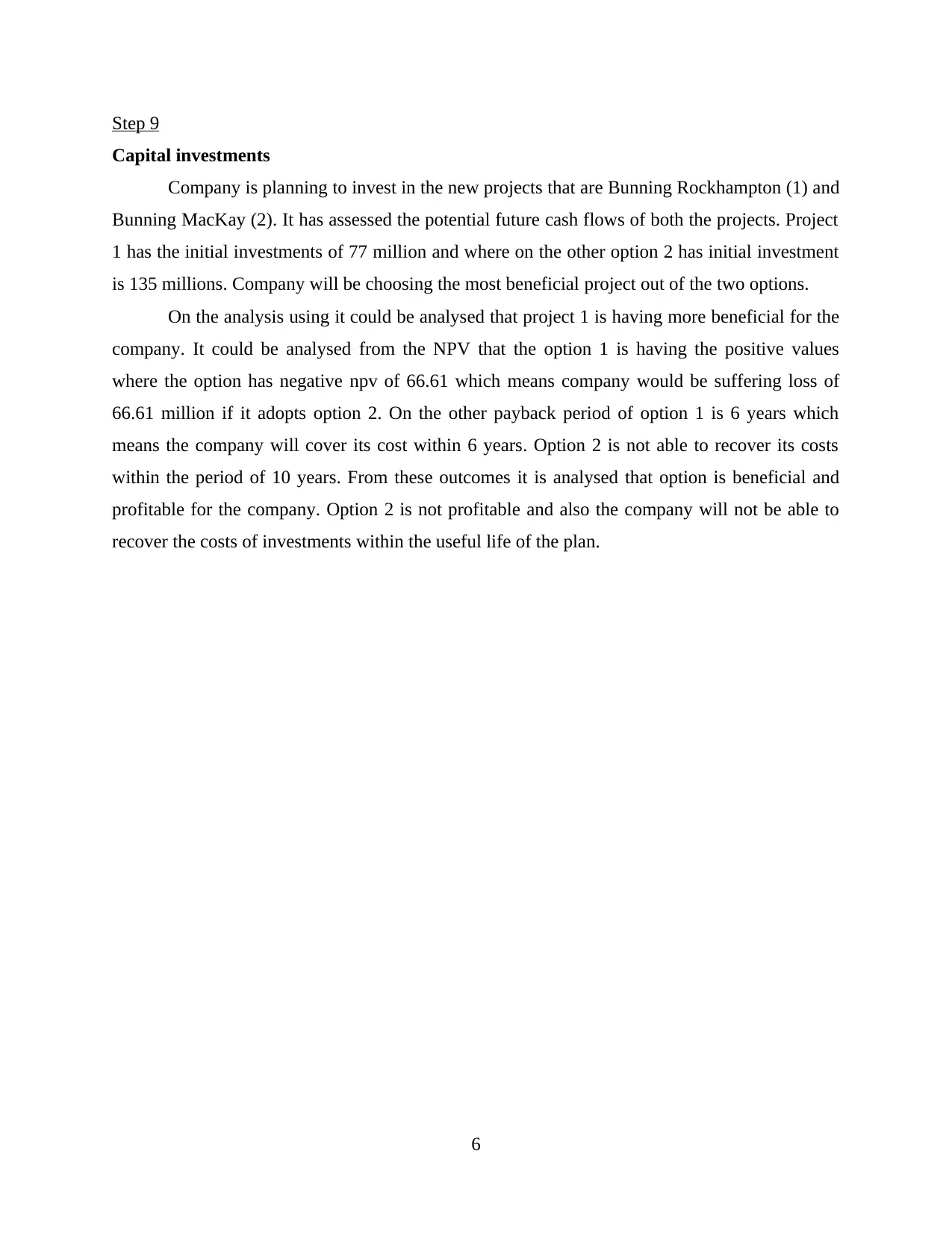
Step 9
Capital investments
Company is planning to invest in the new projects that are Bunning Rockhampton (1) and
Bunning MacKay (2). It has assessed the potential future cash flows of both the projects. Project
1 has the initial investments of 77 million and where on the other option 2 has initial investment
is 135 millions. Company will be choosing the most beneficial project out of the two options.
On the analysis using it could be analysed that project 1 is having more beneficial for the
company. It could be analysed from the NPV that the option 1 is having the positive values
where the option has negative npv of 66.61 which means company would be suffering loss of
66.61 million if it adopts option 2. On the other payback period of option 1 is 6 years which
means the company will cover its cost within 6 years. Option 2 is not able to recover its costs
within the period of 10 years. From these outcomes it is analysed that option is beneficial and
profitable for the company. Option 2 is not profitable and also the company will not be able to
recover the costs of investments within the useful life of the plan.
6
Capital investments
Company is planning to invest in the new projects that are Bunning Rockhampton (1) and
Bunning MacKay (2). It has assessed the potential future cash flows of both the projects. Project
1 has the initial investments of 77 million and where on the other option 2 has initial investment
is 135 millions. Company will be choosing the most beneficial project out of the two options.
On the analysis using it could be analysed that project 1 is having more beneficial for the
company. It could be analysed from the NPV that the option 1 is having the positive values
where the option has negative npv of 66.61 which means company would be suffering loss of
66.61 million if it adopts option 2. On the other payback period of option 1 is 6 years which
means the company will cover its cost within 6 years. Option 2 is not able to recover its costs
within the period of 10 years. From these outcomes it is analysed that option is beneficial and
profitable for the company. Option 2 is not profitable and also the company will not be able to
recover the costs of investments within the useful life of the plan.
6

7
You're viewing a preview
Unlock full access by subscribing today!
1 out of 9
Related Documents
Your All-in-One AI-Powered Toolkit for Academic Success.
+13062052269
info@desklib.com
Available 24*7 on WhatsApp / Email
![[object Object]](/_next/static/media/star-bottom.7253800d.svg)
Unlock your academic potential
© 2024 | Zucol Services PVT LTD | All rights reserved.




